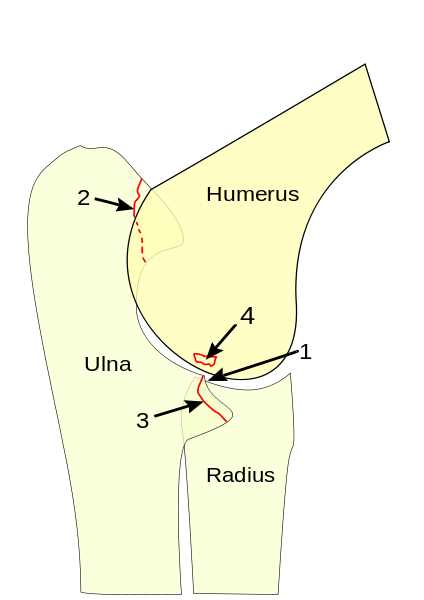(an x-ray of normal hips, from Wikipedia Commons)
A dog may not receive an OFA rating prior to two years of age, which is one reason it is believed that a reputable breeder won't use a dog to produce before that time. Hip dysplasia, in short, is a misalignment of the bones of the hip. It might affect one hip, or both, and though there are surgeries and treatments that can be enacted in order to help a dog out, if a dog and bitch have low scores through OFA or Penn Hip, they should not be bred, because they will pass those hips on to their puppies.
(depiction of hip joint structures in hip dysplasia, from Wikipedia Commons)
Elbow dysplasia involves a misalignment of the radius and ulna in the joint, and separations and fractures in the elbow joint.
1 step between articular surfaces of radius and ulna, 2 isolated anconeal process, 3 fragmented medial coronoid process (FCP), OCD of the medial condyle
(Manifestations of elbow dysplasia in dogs, from Wikipedia Commons)
Things other than genetics can affect dysplasia in dogs. One of these things is inappropriate exercise during the formation of bones; for instance, you don't want to bike with your puppy. Joints are forming, growth plates are still open, and that kind of forced exercise can cause a lot of damage. Additionally, it's more than worthwhile to keep your dog an appropriate weight. Just as extra weight on a human can cause health problems, it has similar ramifications in a dog, and their joints suffer for it.
There are a number of operations to treat hip dysplasia, ranging from trimming the rim of the joint (shudder) to removing the head of the femur, to a total hip replacement. The different procedures are recommended based on the size and weight of the dog. It seems that elbow dysplasia treatments also involve at least one type of surgery (scraping defective cartilage and removing fragments), and also medical options to reduce inflammation. None of these options sound pleasant, you might notice. http://pets.webmd.com/dogs/ is a great informational site, and where I cribbed the operational information from for the purposes of this post.
We want our dogs to have happy and healthy lives. If you decide to go with a breeder, try to make the best choice possible, and choose a breeder who fully health tests his or her dogs. That way, you're giving your prospective family member the best shot at living long and living well.




Very well said! I turned down literally 50 people when I was breeding Mastiffs because they had no idea about proper care or understood what the testing meant!
ReplyDeleteNola's Mom
Good for you! I think a lot of people get enamored of the look or reputation of a breed, without getting into the nuts and bolts of what might go on with them. *cough* I know I kind of....a little...did that. Not as badly as I could have, but I should have researched more.
DeleteSo, how does one go from Mastiffs to dachshunds? ;)
Hi Elka , too right , so many big breeds suffer from these conditions.
ReplyDeleteBest wishes Molly
It's so sad, because we really just want our pets to be happy and healthy!
DeleteHoney's breeder made us sign a contract which included agreeing not to do hard exercise or jumping with her until she was at least 18 months or older.
ReplyDeleteEvery time she jumped off the bed without waiting for us, we held our breaths and hoped we hadn't just broken her. I guess we'll know how good we did as she ages.
Her parents had good hips and elbows. Glad to see how careful our breeder was to pass on only the healthiest genes.
Yes, I'm glad that Honey's breeder took care to go over that kind of information with you! Jumping off the bed probably didn't break her but, I'm not a vet.
DeleteGreat post. Being involved with Labs for so long, you'd think I'd know more about HD than I do. I do know enough to ask about the parents and testing when working with a breeder but this was a great overview of the whole process. And now I can say I learned something today.
ReplyDeleteGlad I could help!
DeleteOf course, this really only scratches the surface of the issue, but it's eye opening, at any rate.
Of course since hip dysplasia is polygenic, there is no guarantee what so ever that two dogs with excellent hip scores won't produce a dysplastic puppy. The tests are just predictors but not full proof. You hope dogs with clearances have enough of the "good" genes to pass on to their get, but it is by no means a guarantee. It is also not true that a dysplastic parent will guarantee a dysplastic pup. Polygenic inheritance is not so simple unfortunately.
ReplyDeleteAlso very true, but one does what one can. Especially because there can be environmental factors as well, I guess you really just cross your fingers, whistle through your teeth, and spit. Everything's a crapshoot anyway, but personally, I won't want to support a breeder who's using a dysplastic sire and dam.
DeleteI also found an interesting pamphlet that Cornell has it, of course after I already published the post. It discusses, or at least mentions (it is a pamphlet), that more research is going into finding which genes it is that make up the issue: http://bakerinstitute.vet.cornell.edu/contentimages/library/File/Canine_Hip_Dysplasia_brochure_11_05.pdf
Thank you for sharingg
ReplyDelete